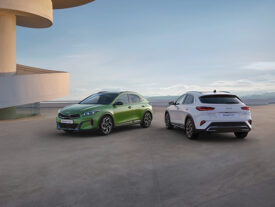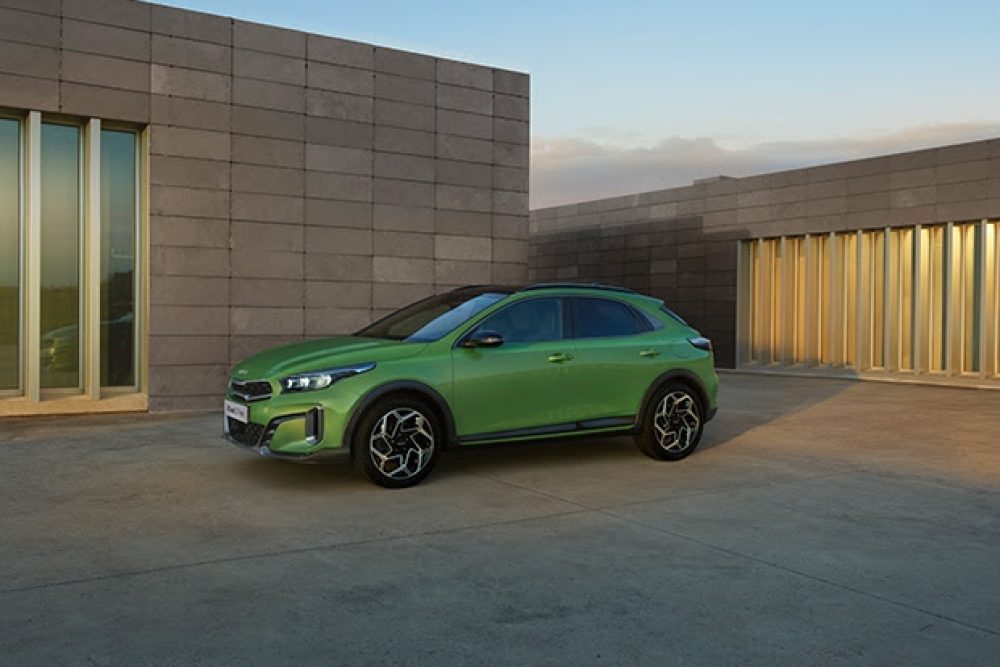What is it?
It’s one of the strangest names on the car market, but it has so much in establishing Kia as a mainstream brand in Europe. The Ceed comes in various guises including hatchback, estate, Sportwagon and GT Line, then there’s the Xceed, a compact crossover which has recently received a bunch of product enhancements including a new exterior design, an improved interior and a new GT-line trim.
The new XCeed integrates a number of design changes alongside a competitive powertrain line-up that includes mild hybrid, plug-in hybrid, petrol and diesel versions. The inclusion of a sporty, GT-line specification for the first time, combined with a gasoline engine that produces 204ps, offers a dynamic appeal.
It comes with the technologies including advanced safety, connectivity and infotainment systems. Designed to improve everyday usability and occupant safety. Kia has also introduced the new XCeed with a wide range of efficient and electrified powertrain options. The XCeed Plug-in Hybrid (PHEV) delivers an all electric range of around 30 miles.
The latest model features new LED headlamps and a revised grille, front bumper and innovative air intake design. By creatively integrating the fog lamps into the headlights, the designers were able to include air curtains on either side which guide air smoothly around the vehicle’s wheels to reduce drag and improve fuel efficiency.
It rides on dedicated 18-inch alloys designed specifically for CUV-segment appeal. At the rear, targeted refinements include a new diffuser with a gloss black skid plate and a discreet ‘exhaust-look’ design for a refreshed sporty look across the XCeed range. In profile, the XCeed’s relatively long bonnet flows into the A-pillars aft of the front wheels, lending the car a sporty, swept-back silhouette.
While the wheelbase remains the same as other models in the Ceed line-up at 2,650mm, the XCeed’s front and rear overhangs have been extended over the five-door hatchback by 25mm at the front (to 905mm) and 60mm at the rear (to 840mm). The only body panels carried over from its five-door hatchback sibling are the front doors.
The XCeed’s elevated ride height and sculpted body present a robust image withs ground clearance 172mm on 16-inch wheels and 184mm on 18-inch wheels, a rise of up to 44mm over the Ceed five-door hatchback. Wheel arch and side sill cladding, along with satin chrome roof rails, lend the car a tough presence.
With the introduction of the GT-line, Kia brings sporting appeal to the XCeed and features a series of sporting touches that differentiate it from the baseline model. An edgy tiger nose design frames the new front grille, while a sporty lower air intake and side bumper cladding adds a more aggressive look to the front end. Air curtains finished in dark chrome help to feed air through the front of the car to reduce drag and enhance aerodynamic efficiency. At the rear, new hexagonal shaped LED tail-lights and a sporty body-coloured lower diffuser complete the revamped model.
The latest XCeed is powered by a range of fast-revving, turbocharged gasoline engines, the majority of which feature mild-hybrid technology, while an advanced plug-in hybrid powertrain enables drivers to benefit from extensive emissions-free mobility.
Three turbocharged gasoline direct injection (T-GDi) engines are available, a three-cylinder 1.0-litre T-GDi engine delivers 120 ps and 172 Nm of torque, while a four-cylinder 1.5-litre T-GDi engine produces 160 ps and 253 Nm of torque. A high-power 1.6-litre T-GDi engine, the same unit found in Ceed and ProCeed GT models, is also available for the most powerful XCeed variant. With a 204 ps power output and 265 Nm of torque across a broad range of engine speeds, the muscular 1.6-litre T-GDi engine perfectly matches the car’s ability to thrive in a variety of driving situations. It can accelerate from 0-to-100 kph in 7.5 seconds when equipped with the seven-speed dual-clutch transmission.
Ideal for those who regularly cover long distances, the new XCeed is also available with a diesel mild-hybrid electric vehicle (MHEV) powertrain. This 1.6-litre diesel engine can be paired with a six-speed manual transmission to deliver 136 ps and 280 Nm of torque, or 320 Nm with the seven-speed dual-clutch version.
The MHEV system supplements the engine’s torque output with power from a compact 48-volt lithium-ion polymer battery that is now available across the entire model family. The roll-out of new mild-hybrid powertrain technology across the updated XCeed range reduces CO2 emissions by up to 10 per cent (NEDC 2.0, combined cycle), depending on body style, choice of transmission, engine power output and vehicle specification. Importantly, while the adoption of MHEV technology improves fuel efficiency, engine performance remains the same as before.
Instead of a hydraulic control, the XCeed is fitted with the brand’s intelligent Manual Transmission (iMT) which operates purely electronically and is integrated seamlessly with the EcoDynamics+ powertrain. The iMT system works with the Mild-Hybrid Starter-Generator (MHSG) to switch off the engine when the vehicle is coasting to a halt. In the XCeed’s default ‘Eco’ drive mode, it also enables brief periods of ‘engine-off’ coasting at speeds of up to 77 mph, seamlessly reactivating when the driver pushes the accelerator, brake or clutch pedal. The system contributes to the MHEV’s overall fuel efficiency improvements and reduces CO2 emissions by around 3% in real-world driving conditions.
A highly efficient plug-in hybrid (PHEV) powertrain option is once again available in the new XCeed, combining an 8.9 kWh lithium-polymer battery pack, a 44.5 kW electric motor, and an efficient 1.6-litre ‘Kappa’ four-cylinder GDI engine. Paired with a six-speed dual-clutch transmission (6DCT), the PHEV transmits up to 141 ps and 265 Nm to the front wheels, while drivers will also benefit from an all-electric range of 48km, equating to 60km of city driving. This will enable drivers to complete the majority of daily drives and short commutes solely on electric power.
The six-speed manual gearbox is available on the 1.0- and 1.5-litre petrol variants along with 1.6-litre diesel models, while the seven-speed dual-clutch transmission is a choice for the 1.5-litre T-GDi, 1.6-litre T-GDi and 1.6-litre diesel versions. The XCeed plug-in hybrid 1.6-litre model is only available with the six-speed dual-clutch box.
What do we think?
The new XCeed’s ride and handling characteristics were developed by Kia’s European engineering teams for comfort and engagement in all conditions. Despite its elevated ride height, the new XCeed has been designed to be engaging to drive due to its bespoke suspension tuning, compact exterior dimensions, lower centre of gravity and reduced mass.
Setting the car up specifically for European roads has certainly hit the spot rather than adopting the one side fits all approach of many other carmakers. Uniquely in the Ceed model line-up, the Kia XCeed features front hydraulic rebound stoppers, fitted as standard to the front axle of all models. The rubber bump-stop floats in hydraulic fluid within the shock absorbers, providing a highly compliant ride over poor surfaces. The car has been designed to absorb even large suspension shocks with a smooth and progressive response, preventing the body from bouncing as the suspension settles itself after rapid compression. It also contributes toward more responsive steering and improved overall body control, while reducing noise from the suspension over bumps.
The XCeed’s spring rates are 7% softer in the front and 4% softer in the rear to deliver greater comfort and stability in all conditions, while a dynamic damper for the rear cross-member further quells road noise and structural vibrations on the move.
The electronic control unit (ECU) governing the power steering motor is tuned to deliver a quicker initial response to steering inputs. This ensures drivers can enjoy quick steering responses and reduced levels of body roll. The level of assistance provided by the power steering motor delivers subtly lighter overall steering to reduce driver fatigue on longer journeys and at low speeds.

Infotainment, connectivity and safety technologies are pretty comprehensive. A 10.25-inch touchscreen navigation system features Bluetooth multi-connection as standard, enabling occupants to connect two mobile devices at once, while Android Auto and Apple CarPlay functionality are also standard. Depending on vehicle specification, XCeed users can also choose between a 5.0-inch DAB-radio system or an 8.0-inch audio display touchscreen system featuring wireless Android Auto and Apple CarPlay.
Drivers can opt for a fully-digital 12.3-inch Supervision instrument cluster that benefits from a number of new graphical themes which alter in response to the selected driving mode; ‘Eco’, ‘Normal’ or ‘Sport’. With a high-definition 1920×720 digital display, vehicle and engine speed dials are displayed in pin-sharp clarity, while a multi-function display communicates turn-by-turn navigation instructions, audio information, in-depth trip information, vehicle diagnostics alerts and pop-up notifications linked to the car’s various active safety and driver-assist technologies.
The new Sports feature means customers will never miss out on the action from their favourite team while on the move. Live scores and game highlights are updated every minute on the centre screen. The display can be customised to add favourite teams to a list for quick access, and can also show current league standings, or if a sport is currently ‘off season’.

The Kia Connect system uses its own eSIM card to retrieve and update live data during a drive. This includes live traffic information, weather forecasts, points of interest, and details of potential on- and off-street parking (including price, location and parking availability). Drivers can use Kia Connect to plan journeys in advance by sending navigation data via smartphone to the vehicle before a journey, while users can also access the app to locate their vehicle, ideal in large car parks or in surroundings that are unfamiliar.
The latest variant of Kia Connect adds the personalised user profile function allowing the customer to create two customised user profiles. This feature enables users to back-up their in-vehicle Kia Connect preferences via the cloud and transfer settings from one vehicle to another. This is designed for customers who often switch between different Kia Connect-equipped cars, such as fleet drivers who use pool cars, or families with more than one Kia Connect-equipped vehicle in their household.
Other features include a JBL Premium audio system with Clari-Fi technology, dual-zone air-conditioning, heated electric folding door mirrors, a heated steering wheel, a heated windscreen, and heated and ventilated front seats and heated rear seats. The new XCeed brings USB Type-C ports for front and rear passengers, while fast-charging capability further enhances convenience on the move.
There is a wide range of active driver-assist and safety technologies to provide ultimate peace of mind and protection. Smart Cruise Control (SCC) is upgraded with the addition of the navigation-related function. Navigation-assisted SCC (NSCC) benefits from an Auto-set function which automatically adjusts the XCeed’s cruising speed according to the maximum set for that road in the navigation’s on-road data system.
In addition to the Auto-set function which controls maximum speed, NSCC also adds ‘zone’ functionality (NSCC-Z) which reduces vehicle speed in ‘safe zones’ identified in the navigation system. Once out of the ‘safe zone’ the system will return the vehicle to its previous cruising speed.
An additional development of the NSCC seen on the XCeed is the Curve function (NSCC-C) which uses the navigation data to predict an upcoming bend in the road, reduces cruising speed if needed to go through the corner safely, and then returns to the preset speed once the corner has been navigated.
As with every Kia sold in Europe, the new XCeed is equipped as standard with Vehicle Stability Management. This aids stability when braking and cornering by controlling the car’s Electronic Stability Control (ESC) system if it detects any loss of traction.
The Blind-spot Collision-Avoidance Assist (BCA) works hand in hand with the Blind-spot Collision Warning system (BCW). Using the same sensors located in the rear bumper, BCA adds preventative measures should the driver begin to turn into a lane when another vehicle is present in the driver’s blind spot. Coupled with the audio and visual alerts present in the BCW, the system applies brake pressure to the wheels on the opposite side of the car, which guides the vehicle back into the original lane.
Driver Attention Warning Plus (DAW+) system monitors the usual driving habits and behaviour of the driver to learn the driver’s usual tendencies and driving patterns. When the system detects any irregularities which may indicate driver fatigue or distraction, it alerts the driver with visual and audio warnings. A coffee cup icon appears on the dashboard along with an audible alert to warn the driver that they are either driving carelessly or should consider taking a break. DAW+ also emits an audible alert and a visual warning if the car in front moves away and the driver does not react.
Rear Cross-Traffic Collision-Avoidance Assist (RCCA) uses sensors in the rear bumper and a rearview camera to give the driver a better view and understanding of what is behind the vehicle when reversing out of a parking space. The sensors alert the driver of oncoming traffic to the left or right of the vehicle before they come into view. If the system detects a vehicle rapidly approaching, a warning chime will sound and an icon on both side mirrors will illuminate to notify the driver that a collision may be imminent. If the driver does not react, the system brakes automatically to avoid a collision. Parking manoeuvres are also made easier with the Smart Parking Assist function which uses a series of sensors to aid with parking in tight spaces.
Further safety features include Forward Collision Warning with car and pedestrian detection, Intelligent Speed Limit Warning, Lane Keeping Assist, Lane Following Assist, Highway Driving Assist and High Beam Assist.








